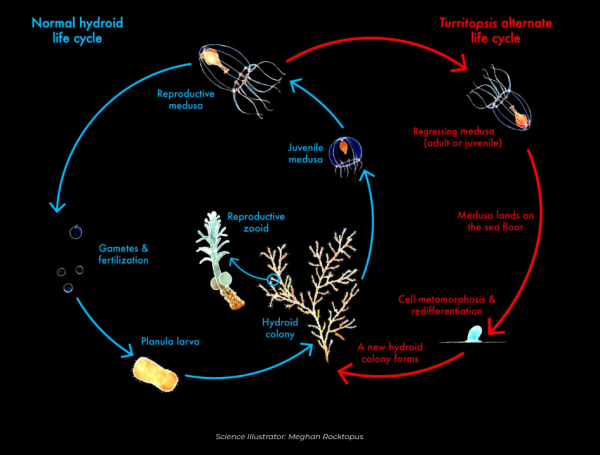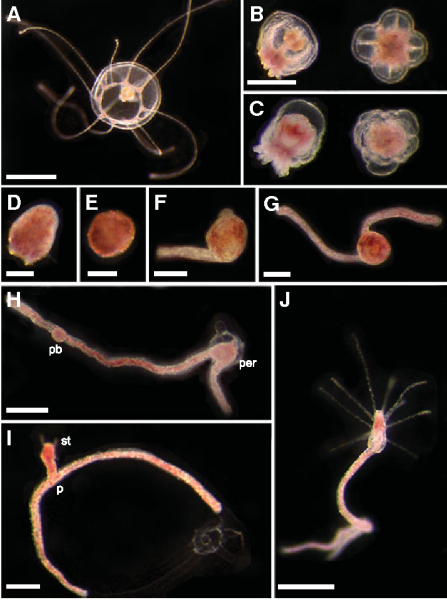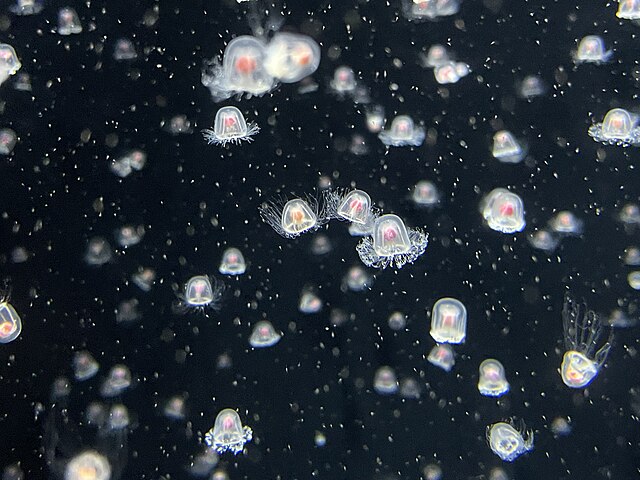First described from Italy in 1883 under the name Dendroclava dohrnii by Dr. August Weismann, the immortal jellyfish is thought to have originated in the Mediterranean Sea. Now-named Turritopsis dohrnii, the jellyfish is sighted worldwide likely by accidentally hitchhiking ship ballast water.

However, researchers only uncovered T. dohrnii‘s unique life cycle recently. In the late 1900s, Bavestrello et. al. collected immature jellyfish by the coast of Italy, leaving the jellyfish in a tank to reach sexual maturity and breed for an upcoming project. The researchers eventually forgot about them. When they returned, expecting completely mature jellyfish called medusae, they faced unusually few and many embryonic polyps instead. In September 1988, the researchers collected more jellyfish colonies on the edge of Portofino Promontory to learn more about their unique life cycle. Their findings in a 1992 publication catalyzed a new wave of research into T. dohrnii‘s immortality.
The immortal jellyfish’s unique life cycle
T. dohrnii shares a life cycle similar to that of most other jellyfish species. Beginning as fertilized eggs, they develop into free-floating planulae until attaching to a hard surface and growing into a polyp. This polyp asexually reproduces into a colony of many immature jellyfish that bud off and mature into fully grown medusae.
Stressors like starvation and damage typically lead other species to death. However, unique to T. dohrnii, these stressors trigger the medusa to absorb its tentacles and fall to the sea floor in a cyst. Within 24 to 36 hours, the cyst regenerates into a polyp and continues a typical life cycle back into a medusa. This process has been shown to occur up to 10 times a month, and theoretically, continue indefinitely.

How do they regenerate?
Among the numerous processes of jellyfish regeneration, transdifferentiation is one of the most notable because of its more prominent role. Compared to differentiation, which specializes stem cells, transdifferentiation specializes an already specialized cell to another cell type. This could occur directly or through dedifferentiation, a process that reverts a specialized cell to a stem cell.
When the T. dohrnii regenerates, it undergoes transdifferentiation from its medusa cells to its cyst cells. In this stage, the cells reduce replication and responses to external stimuli to focus on elongating telomeres, the tips of chromosomes that protect DNA from damage. Every time a cell replicates, such as to repair an open wound, the telomeres shorten and decrease DNA protection, leading to signs associated with aging and ultimately death. Therefore, telomere elongation is crucial not only to renew the degraded telomeres but also to protect the DNA from future damage.
Early research from another―albeit less―regenerative jellyfish found phenomenons that may explain the physiological details of T. dohrnii‘s full-body transdifferentiation. Without pre-occurring DNA replication, the isolated and striated muscle cells of jellyfish Podocoryna carnea develop flagella and degrade myofibrils to transdifferentiate into a cell type that resembles something between smooth and striated muscle. With certain treatments, these cells behaved akin to stem cells.

Further experiments found that these cells transdifferentiate into roughly seven different cell types, namely smooth muscle and neurons. Under certain conditions, the transdifferentiated cells can even self-organize into tentacles or manubrium, a handle-like feeding organ. Trials indicate that repression of a striated-muscle marker, an expression of a stem cell marker, and an expression for an embryonic dedifferentiation marker influence this stem cell behavior. Similar transdifferentiation processes were likely to occur with T. dohrnii as well.
Now, more factors have been shown to participate in jellyfish regeneration. In 2022, researchers from the scientific journal PNAS utilized software to compare the genes of the immortal T. dohrnii and a mortal Turritopsis species to narrow down any variant or amplified genes associated with aging in either jellyfish. In T. dohrnii, they found amplified replication genes (e.g. POLD1, which encodes a type of DNA polymerase, an enzyme that contributes to DNA replication) and duplicated genes that enhance DNA repair (e.g. GEN1, which encodes for endonuclease, an enzyme that cuts DNA for repair).
Similarly, they found factors that more directly focus on telomeres and their cellular regeneration. For example, other jellyfish have only one copy of GAR1, a protein-nucleic-acid complex that enhances telomerase, an enzyme that contributes to telomere elongation, while T. dohrnii fosters two. However, more research is needed on wild-type medusa; most studies are conducted in vitro due to their translucent 4.5-millimeter size.
A future with immortality
Despite the incredible ability of T. dohrnii, the jellyfish still fall victim to predation and climate change, nature seemingly controlling an inevitable balance of life. Likewise, immortality for humans will be in the far future, and even then, subjected to the whims of natural events. Though to start our research for immortality sooner, maybe Ponce de León should have sailed South to find his fountain in the Mediterranian Sea.
Interested in researching more? Some of my favorite sources used in this article:
Die Entstehung der Sexualzellen bei den Hydromedusen – the 1883 scanned papers of Dr. Weismann’s first-ever description of T. dohrnii in the Bay of Naples, Italy (written in German)
The Real Immortal Jellyfish – an amazing website dedicated to T. dohrnii research (with pictures!) created by the Miglietta laboratory from Texas A&M
A silent invasion – a 2018 study by Dr. Miglietta about T. dohrnii ecology, notably the differences between temperate and tropical T. dohrnii medusae
Bi-directional conversion in Turritopsis nutricula (Hydrozoa) – the infamous 1992 research paper that catalyzed research into T. dohrnii regeneration
Comparative genomics of mortal and immortal cnidarians unveils novel keys behind rejuvenation – incredible 2022 research about the genetic factors that contribute to jellyfish regeneration
The Incredible Way This Jellyfish Goes Back In Time – a beautifully detailed yet short YouTube video of the history and science behind T. dohrnii































